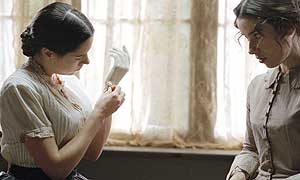Well, I’m afraid I did it again.
My night owl tendencies got the better of me and I stayed up until 3:30am. Don’t ask me how I’m functioning today; I don’t know the answer.
What was I doing until the wee hours of the night (or morning)? Watching Fingersmith, an adaptation of the Sarah Waters novel by the same name
.
You’re probably familiar with Sarah Waters (and if you’re not, you should be!). She writes these amazing lesbian romance / lesfic books set in an England of the past. I’ve read her novel Tipping the Velvet and really enjoyed it; I’m sorry to say I haven’t read her other books. Tipping the Velvet and Fingersmith are both set in the same era; roughly England during the Industrial Revolution, so I would guess late 19th / very early 20th century.
To me, the historical fiction aspect of Sarah Waters’ writing is part of what makes her work so captivating. She’s a fantastic writer regardless of the setting, but what I love is how vibrant the world around her lesbian characters can be. I think that it’s a little easy for us as 21st century LGBTQ people living in the West to get complacent and forget that in the past, and even today in many places in the world, being gay was (is) very dangerous. So when I read / watch her work, I can’t help but wonder: Would I have survived, mentally and physically, if I had been born in that era?
Anyway. On to the review.
Synopsis & Plot
Here’s a good synopsis I found on Kissing Fingertips that doesn’t give away too much:
As with all films that involve intrigue of some kind, to outline too much of the plot is to do both the film and the audience a disservice. In broad terms, Fingersmith follows the story of Sue Trinder (Sally Hawkins) and Maud Lilly (Elaine Cassidy), two young women whose pasts are intertwined in ways they could not possibly imagine and who are caught up in a scheme twenty years in the making. At the behest of a con man named “Gentleman” (Rupert Evans), and with the encouragement of her foster-mother Mrs Sucksby (Imelda Staunton), Sue agrees to help in a plan to rob Maud; a young, wealthy girl who lives at the country estate of Briar.
According to Gentleman, Maud Lilly, who lives alone with her eccentric uncle, is due to come into her inheritance of forty thousand pounds when she marries. However, Mr Lilly keeps her so locked up and isolated as to negate the possibility of that ever happening. Gentleman proposes to pose as Mr Richard Rivers, a suitor for Maud and an employee of her uncle, while Sue poses as Maud’s maid. Her role in the con is to help convince the naive, impressionable Maud that she is in love and ought to run away and marry Rivers. After that has happened, Rivers will have Maud locked up in an asylum and take her cash for himself. Sue’s share in the booty will be three thousand pounds.
Of course, if the scheme went exactly as planned there would be no story. Things start to go desperately awry when Sue and Maud begin to develop feelings for one another. The unravelling of the con and the unveiling of the characters’ different motivations forms the bulk of the plot.
Hands & fingers: Some (nerdy) little things I noticed and enjoyed
When I watch movies and read books, I’m always looking at them with two sets of eyes — the eyes of a fan and the eyes of a writer. Through my writer’s eyes, one thing I loved about this movie (mini-series, technically) was the title and double meaning of “fingersmith.”
Fingersmith… now what kinds of images does that conjure up??
Hey — get your mind out of the gutter! 😉 A fingersmith, of course, is slang for thief. But given the context of this being a lesbian romance, naturally it also has another meaning.
This motif of the meaning and use of our hands and our fingers is carried throughout the story. For example, one of the two main characters, Sue, is the one who self-identifies herself as a fingersmith / thief. But later in the movie, she’ll be the one to be a fingersmith in a different way.
When we meet Maud, the other main character, one of the first things her cruel uncle does to punish her is make her hold out her hands and have them painfully whipped because she refused to wear gloves. From then on, she is never without her dainty white gloves. It’s a perfect image to describe Maud’s repression, as well as the way her uncle steals away her freedom. The gloves she wears while in her uncle’s study may as well be handcuffs; the gloves she wears at night while she writhes with nightmares show how she’s not free even within her own dreams; the gloves lined up neatly in her drawer show how deeply she has internalized her own captivity. And of course, with the “fingersmith” double meaning, the gloves also represent her stifled, repressed sexuality.
Then the gloves come off: The male villain takes them off and kisses Maud’s bare hands, sending a poignant reminder to us as viewers that it’s not just our lips and breasts and genitals that are organs of sensual pleasure; our hands and fingers also fall into this category.
But the villain’s treatment of Maud’s hands also represent male dominance within this Victorian world, in which it’s not just LGBT people who are powerless, but women in general. The villain’s kisses to Maud’s hands are sensual, but unwanted.
Later, when Maud and Sue finally get together (I mean, that’s not a spoiler, right? — it’s a romance so you knew it would happen eventually), Sue also takes off Maud’s gloves and kisses her hands and fingers. The contrast between the villain and Sue show how one action can have two very different meanings depending upon context.
But Maud’s not the only one who has a thread of fingers and hands running throughout the movie; Sue does, too, although hers are often not quite as obviously symbolic. For starters, as already mentioned, the “fingersmith” title itself refers to Sue in two very different ways. But we also see the hands / fingers motif repeated in other ways.
In particular, as the sexual tension between Maud and Sue heat up, we are reminded of all the ways in which even the most subtle touches can be significant: We see Sue filing Maud’s nails, brushing Maud’s hair, dressing Maud, even holding Maud’s hands while they sleep (“platonically”) together.
And speaking of the platonic sleeping together, there’s an interesting moment near the beginning where one of Sue’s hands is trapped by Maud and she gently extracts it without waking the other girl. In hindsight, this is an interesting foreshadow.
Towards the end of the film (and I’m going to be vague so as to avoid spoilers), Sue applies hand cream to another woman’s hand as part of a scheme to deceive her. And meanwhile, Sue steals one of Maud’s famous gloves. The glove’s meaning shifts for Sue as time goes on; first it’s a reminder of her love for Maud, later it once again becomes a symbol of imprisonment.
Last point: I want to check out the Korean re-imagining of this story
A French reader of mine mentioned that there is also a Korean version of this same film. Sticking with the same hand / finger motif, this one is called The Handmaiden. Based on the Wikipedia plot summary, it looks like this one has some twists and turns that the original does not.
Has anybody seen it?



0 Comments